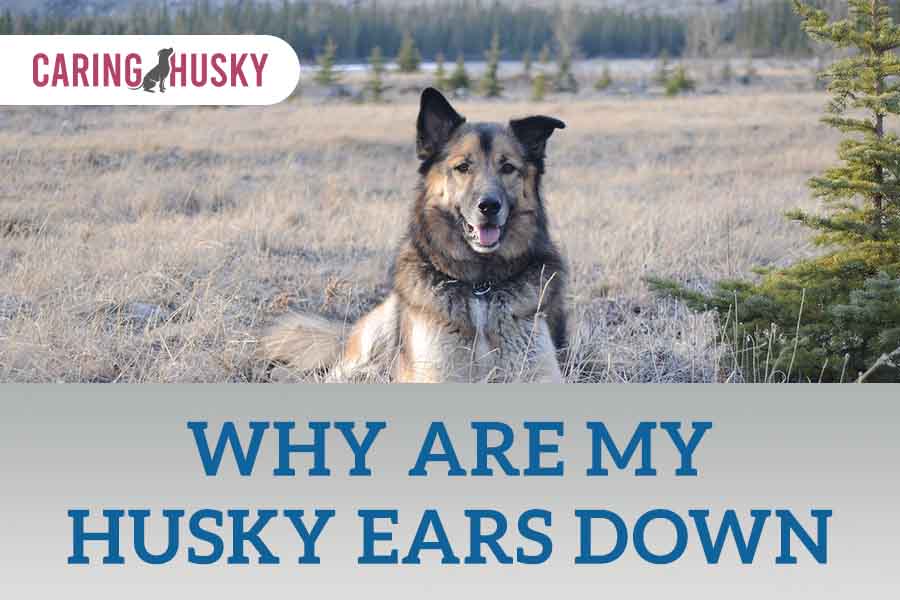The ear posture of a husky can be a fascinating window into their world, reflecting their emotions, health, and environment. For husky owners and enthusiasts, the question of “Why are my husky’s ears down?” often arises, prompting a deeper exploration into the various factors that influence this distinctive breed’s ear position. Understanding the causes behind down ears is not only essential for interpreting your husky’s mood and well-being but also for providing them with the care they need. In this comprehensive article, we will delve into the anatomy of husky ears, examine emotional, health, and environmental factors, and offer practical insights into training and socialization to ensure your husky’s ears stand tall in any situation.
Why Are My Husky Ears Down?
Husky ears can be down due to various reasons, including fear, anxiety, stress, ear infections, allergies, or discomfort. Environmental factors like extreme weather or noise can also contribute. Proper training and socialization can help improve ear posture, but if it persists, consult a veterinarian to rule out underlying health issues.
How Husky Ears Are Different From Those Of Other Dog Breeds?
Husky ears differ from those of other dog breeds in several ways:
- Size And Shape: Husky ears are medium-sized and triangular, standing erect when alert. In contrast, some breeds have floppy ears, while others have smaller, rounded ears.
- Double Coat: Huskies have a double coat, including an insulating undercoat. Their ears may appear fluffier compared to breeds with single coats.
- Mobility: Huskies have highly mobile ears, allowing them to rotate and pivot to capture sounds efficiently. This mobility aids their survival in cold climates.
- Cold Adaptation: The unique ear shape and size of huskies help protect against frostbite in freezing temperatures.
- Expressiveness: Huskies use their ear position to convey emotions and communicate with their owners, making their ear posture an essential part of their body language. Overall, huskies’ ears are adapted to their cold environment and play a vital role in their communication and survival.
How A Husky’s Emotions Can Affect Their Ear Posture.?
A husky’s ear posture is closely linked to their emotions and can be a clear indicator of their current state of mind. Here’s how a husky’s emotions can affect their ear posture:
- Happiness And Alertness: When a husky is happy, excited, or alert, their ears are typically erect and pointing forward. This posture signifies a positive and engaged emotional state.
- Relaxation: In moments of relaxation and contentment, a husky’s ears may be in a neutral position, neither fully erect nor down. This suggests that they are at ease and not experiencing any immediate stress.
- Fear And Anxiety: Fearful or anxious huskies often have their ears pulled back against their head. This posture is a defensive response, indicating that they feel threatened or uneasy.
- Submission: If a husky is feeling submissive or trying to appease a more dominant individual, they may lower their ears to the sides of their head or even flatten them against their skull. This is a sign of submission and a desire to avoid confrontation.
- Aggression Or Agitation: When a husky is agitated, angry, or showing signs of aggression, their ears may be erect and forward, sometimes accompanied by a slight tilt. This posture can indicate heightened alertness and a readiness to react.
- Pain Or Discomfort: If a husky is experiencing pain or discomfort, they may hold their ears differently depending on the source of the discomfort. Ear infections, for example, can cause a husky to hold their ears down or to the side.
- Confusion Or Curiosity: Curiosity or confusion can lead to a husky tilting their head to the side while keeping their ears upright. This adorable head tilt is often seen when they encounter something new or puzzling.
Training And Socialization
Training and socialization are key aspects of ensuring your husky’s well-being and behavior, including their ear posture. Here’s a closer look at how these factors play a crucial role:
Basic Obedience Training:
Start with basic obedience training commands like “sit,” “stay,” and “come.” Training should be consistent and positive reinforcement-based. Teach your husky to respond to verbal cues and hand signals, reinforcing a strong communication bond.
Socialization:
Early socialization is vital. Expose your husky to various people, animals, and environments during their puppy stage to prevent fear or aggression. Well-socialized huskies tend to have more relaxed and confident ear postures in new situations.
Positive Reinforcement:
Use positive reinforcement techniques, such as treats and praise, to reward desired behaviors.Avoid punishment-based methods, as they can lead to fear and anxiety, which may manifest in down ears.
Exercise And Stimulation:
Huskies are active breeds and require plenty of exercise and mental stimulation. Regular exercise helps alleviate stress and anxiety. Provide engaging toys and activities to keep your husky mentally engaged and prevent boredom.
Consistency And Routine:
Establish a consistent daily routine for feeding, exercise, and playtime. Huskies thrive on predictability and structure. Consistency in training commands and expectations helps them understand their role in the family.
Professional Training:
Consider enrolling your husky in obedience classes or seeking the help of a professional dog trainer, especially if you encounter behavioral challenges. Professional trainers can address specific issues and provide guidance tailored to your husky’s needs.
Positive Social Interactions:
Encourage positive social interactions with other dogs and people. Well-adjusted huskies are more likely to exhibit confident ear postures in social settings.
Desensitization:
Gradually expose your husky to situations that may trigger anxiety, like loud noises or crowded places. Use desensitization techniques to help them become more comfortable and less likely to display down ears in stressful situations.
Breed-Specific Considerations
Understanding breed-specific considerations is essential when caring for a husky, including their unique ear-related characteristics. Here are some key points to keep in mind:
- Cold-Weather Adaptation: Huskies are a cold-weather breed originally from Siberia. Their ears, with their thick fur, help protect against frostbite in freezing temperatures. In colder climates, it’s important to ensure your husky is adequately sheltered and protected from extreme cold to prevent discomfort and potential ear-related issues.
- Communication Style: Huskies have a distinct communication style that includes vocalizations, body language, and ear position. Understanding their communication cues, including ear posture, allows for better interaction and bonding.
- Independent Nature: Huskies are known for their independent and sometimes stubborn nature. This can influence their response to training and their ear posture. Be patient and consistent in training, and respect their need for some independence.
- Exercise Requirements: Huskies are a high-energy breed that requires ample exercise. A well-exercised husky is more likely to have a confident and alert ear posture. Ensure they have opportunities for regular physical activity.
- Pack Mentality: Huskies have a strong pack mentality and often thrive in a family environment. They may exhibit submissive ear postures when interacting with dominant individuals within the family.
- Socialization Needs: Early socialization is crucial for huskies to prevent fear or aggression in various social situations. Expose them to different people, animals, and environments to build confidence.
- Grooming: Huskies have a thick double coat that requires regular grooming to prevent matting and shedding. Proper grooming can help maintain the appearance and health of their ears.
- Health Awareness: Huskies are prone to certain health issues like hip dysplasia and eye conditions. Regular veterinary check-ups are important to address any potential health-related ear problems.
- Nutrition: Provide a balanced diet suitable for active breeds like huskies. Proper nutrition contributes to overall well-being and can affect ear health.
- Environmental Considerations: Huskies may be sensitive to extreme temperatures, so provide adequate shelter and protection from heat and cold. Be mindful of their surroundings, as environmental factors can influence ear posture.
Conclusion
In conclusion, understanding the intricacies of a husky’s ear posture is not only essential for interpreting their emotions and well-being but also for fostering a strong and harmonious bond between husky owners and their beloved pets. By recognizing the influence of emotions, health, training, and breed-specific traits, you can ensure that your husky’s ears reflect their comfort, confidence, and happiness. Remember, a well-cared-for husky with ears held high is not only a sign of physical health but also a testament to the nurturing environment you provide as a dedicated husky owner.
FAQ’s
Why Do Huskies Have Erect Ears?
Huskies have erect ears to efficiently capture sounds in their cold, Arctic environment. This adaptation aids in hunting and survival.
Can Huskies Have Floppy Ears?
While rare, some Huskies may have floppy ears due to genetics. However, erect ears are the breed standard.
Why Do Husky Puppies’ Ears Flop?
Husky puppies’ ears may flop initially but typically become erect as they grow and their ear cartilage strengthens.
How Can I Train My Husky To Have Erect Ears?
You can’t train their ear posture directly, but proper training and socialization can improve their confidence and emotional well-being, leading to more erect ear posture.
Should I Be Concerned If My Husky’s Ears Are Down?
Down ears can indicate various emotions or health issues. It’s important to assess the context and consult a veterinarian if you’re concerned about your Husky’s ear posture.






Leave a Reply